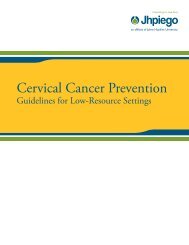Manual for Male Circumcision under Local Anaesthesia
Manual for Male Circumcision under Local Anaesthesia
Manual for Male Circumcision under Local Anaesthesia
Create successful ePaper yourself
Turn your PDF publications into a flip-book with our unique Google optimized e-Paper software.
<strong>Male</strong> circumcision <strong>under</strong> local anaesthesia<br />
Version 3.1 (Dec09)<br />
Chapter 8<br />
PREVENTION OF INFECTION<br />
SUMMARY<br />
• Health care workers need to follow recommended practices <strong>for</strong> preventing<br />
infection, in order to protect themselves, other health care workers, and<br />
their patients from exposure to HIV and other infections.<br />
• Hand hygiene greatly reduces the number of disease-causing<br />
microorganisms on hands and arms. It is the most important way of<br />
limiting the spread of infection. If hands are visibly soiled, they should be<br />
washed with soap and water; otherwise, an alcohol-based handrub should<br />
be used.<br />
• Personal protective equipment should be worn to protect both patients<br />
and staff from infectious microorganisms.<br />
• Gloves should be worn: when there is a reasonable chance of hand<br />
contact with blood or other body fluids, mucous membranes, broken or cut<br />
skin; when per<strong>for</strong>ming any invasive procedure; and when handling<br />
contaminated items. A new pair of gloves should be worn <strong>for</strong> each new<br />
patient contact, to avoid spreading infection from person to person.<br />
• Hypodermic (hollow-bore) needles can cause injuries to clinic staff at all<br />
levels: workers can be stuck by hypodermic needles during patient care,<br />
cleaning and housekeeping. Staff may be exposed to needle-stick and<br />
sharp injuries when washing soiled instruments and disposing of waste<br />
material.<br />
• All staff should be trained in the proper handling of sharp instruments.<br />
• Soiled instruments and other reusable items can transmit disease if not<br />
properly cleaned, disinfected and sterilized (or high-level disinfected).<br />
High-level disinfection destroys all microorganisms, except some bacterial<br />
endospores. Sterilization destroys all microorganisms, including bacterial<br />
endospores.<br />
• Proper waste management is important to prevent accidental injury to<br />
people who handle waste items, and to prevent the spread of infection to<br />
health care workers and the local community.<br />
• Post-exposure prophylaxis <strong>for</strong> HIV with antiretroviral drugs may reduce<br />
the risk of infection after exposure to HIV. It will be effective only if it is<br />
started as soon as possible after exposure (within 72 h) and if the full<br />
course of treatment is adhered to.<br />
• Post-exposure prophylaxis <strong>for</strong> hepatitis B can reduce the risk of hepatitis<br />
B infection.<br />
Prevention of Infection Chapter 8-1
















